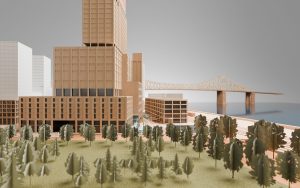MONTREAL — The agency that oversees Montreal’s Olympic Stadium is looking for ideas to reuse the components of the building’s tattered, old roof — including membranes the size of 26 hockey rinks and cables 12 kilometres long.
This week, the Olympic Park launched an international request for submissions from design and architecture students and professionals for ways to give a second life to the materials that are set to be dismantled beginning this summer.
Quebecers will be asked to vote for their favourite among eight ideas selected by a jury of experts who will consider the proposals.
“The competition is open to the international community in order to collect as many suggestions as possible that are optimal for the environment, the economy and society,” the provincial agency that manages the Olympic site said in a statement.Â
An emblematic fixture of Montreal’s skyline, the nearly 50-year-old stadium was designed by French architect Roger Taillibert for the 1976 Summer Olympics, and it served as the home for the Montreal Expos baseball club until 2004.
The stadium is a giant oval with a Teflon-coated fibreglass roof, installed in 1998, and held up by a series of cables attached to a tower 165 metres high that stands on a 45-degree angle, making it the tallest inclined tower in the world, according to the agency.Â
Supporting cables, inner and outer membranes and hardware are among the roof components the agency is looking to repurpose. The total dimension of the roof’s two membranes is 42,000 square metres, roughly the size of 26 hockey rinks; the total length of the cables is about 12 kilometres, as long as Montreal’s St-Laurent Boulevard; meanwhile, the roof includes 434 steel connectors that secure the cables.
In February, the Quebec government announced a project to replace the stadium’s roof for $870 million. Expected to take four years to build, the new roof will have a lifespan of 50 years, allow the stadium to stay open year-round and double the number of annual visitors to the tourist site.Â
The roof’s condition is so fragile that events inside the stadium are cancelled if more than three centimetres of snow are expected to fall, restricting the building to being open between 120 and 180 days a year. Riddled with more than 20,000 tears, the roof is the stadium’s second since the site was inaugurated for the Olympics. The existing roof replaced an earlier retractable Kevlar roof that was installed in 1987, more than a decade after the Summer Games.Â
The new roof will be fixed, rigid and will include a transparent glass hoop around the edge.
Dr. Avi Friedman, an architecture professor at McGill University, said the Teflon roof can certainly be repurposed, as can the cables and other components.
“It’s not simple, but I believe that uses can be found for such material in an age of sustainability or circularity, when we do not get rid or discard,” Friedman said.
It’s becoming increasingly common practice to reuse building materials instead of throwing them away, he said.
“Our frame of mind was to take material, use and then discard it, and most construction material used to end up in the landfill,” Friedman said. “The philosophy now is that you do not design to discard material to make it waste, but to recycle or upcycle.”
Students and professionals have until the end of May to apply and must submit their ideas by June 11. Contest winners could be awarded prizes ranging from $5,000 to $15,000.
©2024 The Canadian Press





Recent Comments
comments for this post are closed